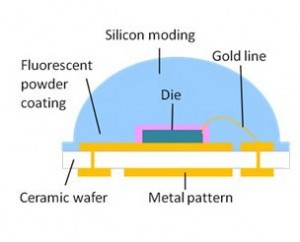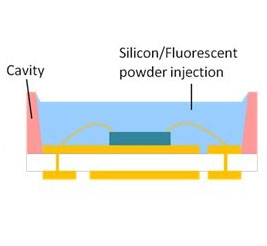LED lights package is based on chip, by the by wire bonding, eutectic or flip chip packaging technology with its heat the substrate Submount (sub-mount technology) link from the LED chip, and then chip on the system board to link into the light source mode group.


At present, LED packaging methods can be broadly divided into the lens type (Lens-type) and the reflector cup (Reflector-type), the molding of which the lens can be molded (Molding) or lens bonding forming; in Figure 1 (a) the said reflector chip molding rubber mixing, dispensing, packaging; shown in Figure 1 (b) below. Epitaxy, solid crystal and the package design in recent years to mature, the size and structure of the LED chip miniaturization every year, 1 ~ 3W high-power single-chip power up, even more than 3W LED chips LED power rising download version and cooling of the system circuit board and heat requirements is becoming increasingly harsh.
Given the comprehensive consideration of the insulation, pressure, heat, and heat, the ceramic substrate to become one of the important material of the chip sub-mount technology. Its technology can be divided into a thick-film technology (Thick film), LTCC technology (LTCC) and made of thin film technology (DPC). However, the thick film technology with LTCC technology using screen printing technology and high-temperature sintering process, easy to produce rough lines, are not precise, shrinking proportion against the increasingly fine line of high power LED products, or requires accurate the eutectic or the flip-chip technology, the LED products, the thick film and LTCC ceramic substrates, have gradually inadequate.
To this end, the high thermal coefficient of thin-film ceramic cooling substrate, the use of sputtering, the electrical / chemical deposition and photolithography process is made, with precision metal lines, the stability of the material system, applicable to high power, small size, high brightness LED the development trend is the solution to the eutectic / flip-chip packaging technology, the stringent requirements of the metal line resolution and accuracy of the ceramic substrate. Ai Secretary Bo electronics in addition to the production of thin-film ceramic cooling substrate, but also to comply with the different lighting needs, and another developed a thin-film ceramic COB (Chip On Board) cooling substrate. The following table is Ai Secretary Bo COB ceramic substrate solution.
When the LED chip to the ceramic as a carrier board, the bottleneck of this LED module heat transferred to the system board, the heat transmitted by the LED chip to the cooling fins and the atmosphere, with the gradual improvement of the LED chip features, materials gradually shift from FR4 to metal core printed circuit board (MCPCB), but with the demand for progress of high power LED, the thermal coefficient of the material in the MCPCB (2 ~ 4W/mk) can not be used for higher power products, ceramic circuit board (Ceramic circuit board) the needs of the increasing popularity, the following table is the analysis of the characteristics of a variety of substrate materials. To ensure that the material stability of LED products in the high-power operation of the light fades stability has become increasingly clear trend of ceramics as heat and metal wiring substrate. Ceramic materials currently cost more than MCPCB, how to use the characteristics of ceramic high-heat coefficient, saves material use area to reduce production costs, to become one of the important indicator of the ceramic LED development. Therefore, in recent years, the integration of polycrystalline ceramic materials COB design package and system lines are gradually subject to the attention of packaging and system vendors.
COB, in the electronics manufacturing industry is not a fresh, refers directly to the bare wafer adhesive in the circuit board and wire / wire soldered directly to the gold-plated line on the PCB, is also commonly known as wire (Wire bonding), through the technology of plastic closures, effective package of steps in the IC manufacturing process transferred to the circuit board assembly directly. In addition, in the LED industry, more and more stress due to modern technology products thin and high portability, directly in order to save system board space for the many LED chip design problems in the demand for high-power LED grow lights system, developed the chip sticky affixed to the system board of COB technology.
The advantages of the COB is: cost-effective, simple circuit design, system board space savings, but also the existence of the chip integrated brightness, color temperature to reconcile the threshold of the technology and systems integration. 25W of LED, for example, the traditional high-power 25W LED light source, with 25 1W LED chip package into 25 LED components and COB packaging is 25 1W LED chip is packaged in a single chip, requiring The second optical lens from the 25 reduced to one, help narrow light area, reduce the material, system cost, and thus simplify the light Department of the secondary optical design and saves assembly labor costs. In addition, high power COB packaging only a single high power LED to replace the more stars 1 watt (or more) LED packaging to promote the product volume of more compact size.
Currently on the market, production COB products still use MCPCB substrate-based, however, the MCPCB still a lot of heat and light area is too large to be solved, so the root of the problem or from the cooling material is updated to the most effective solution. Ai Secretary Bo electronic R & D and production of ceramic COB substrate has the following advantages: a thin film process, the basic line is more accurate, (2) large amount of lower cost, (3) high plasticity, can be partners of different needs to do the design.
The development of COB is to simplify the system board of a trend, practical lighting, brightness, heat, and cost control are key factors. ICP in addition to providing a variety of film cooling substrate to a single chip package to provide the independent development of thin-film line COB substrate to the users of high power use, with its more flexible option to look forward to LED lighting as soon as possible to become more popular of, make a contribution to the Earth green.






